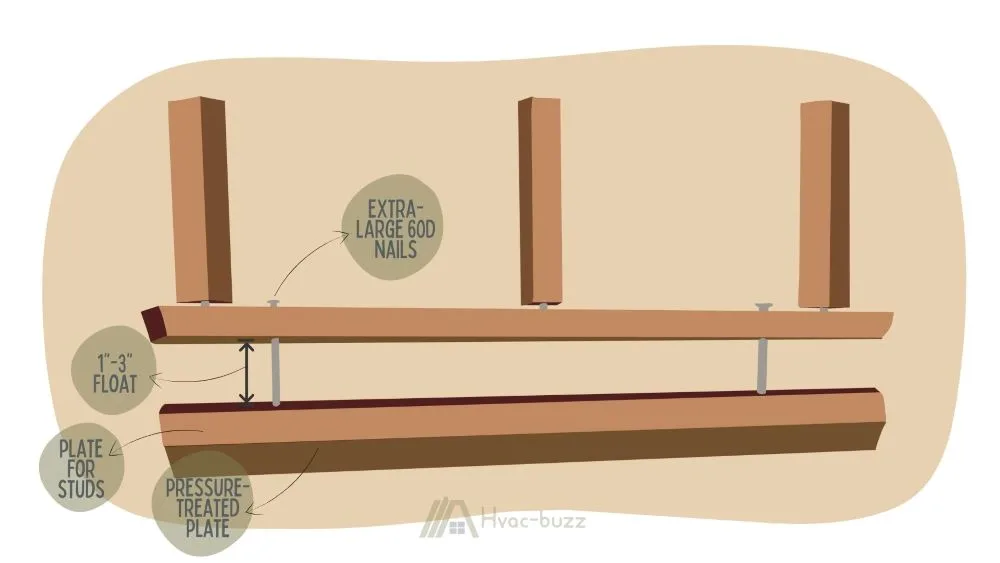What Is A Floating Wall (With Illustrations)
Whether yous accept heard nearly floating walls before, or you have no clue what to imagine under this term, don’t worry. We’ve got you covered!
We’ll dig deep into the theme of floating walls and hash out what their purpose is, how do they function, as well as whether yous ask them or not. In the finish, we will await at the necessary tools too helpful tips for installing a floating wall.

A floating wall is a not-load-bearing basement wall attached securely to the ceiling only attached to the bottom plate amongst long nails too a ane-three” gap between the wall as well as the bottom plate itself. The gap allows for the drive of a foundational slab inward the presence of expansive soils.
Floating Wall definition
A floating wall, as its bring up suggests, does not directly impact the earth. It is attached too hangs from the ceiling higher up it, creating a small-scale gap betwixt the wall as well as the flooring.
Naturally, the wall is not just simply hanging in the air. It is besides anchored to a flooring plate with multiple long nails. This manner of attachment allows for at least an inch gap between the wall and the flooring plate.

What Is the Purpose of a Floating Wall?
Certain types of soils tin rapidly expand when they freeze or get moisture. Due to the increase inward volume, the soil starts pressing against the foundation of a menage. This tends to shift the structure too slightly elevator the flooring, causing floor heaves.
The potential damage caused to the structure by the shifting of foundation varies greatly, ranging from superficial cracks in the drywall or destroying the floor in a higher place to ultimately compromising the construction of a family inwards just about cases.
Even though the expansion of ground doesn’t always have to drive severe impairment, it is even so ameliorate to effort minimizing it where possible.
Floating walls allow the ground to nifty too the foundation to move without pressing against the walls in addition to affecting the rest of the house.
This characteristic makes it a perfect type of wall for basements built inwards expansive soil (every bit is constitute inward Colorado, for instance). Alternatively, it is bully to be used with concrete floor since concrete tends to shift slightly due to atmospheric condition changes.
They enclose the expanse in addition to supply you with an additional infinite where yous tin install shelves too racks. Typically, they are used equally division (curtain) walls inward basements or garages.
Therefore, we could order that the chief purpose of floating walls is to protect the household’sec construction in addition to go far more than stable, while still allowing your basement to live subdivided or finished.
How Does a Floating Wall Work?
Floating walls are attached to the ceiling together with are anchored with 60D nails to a pressure level-treated bottom plate on a flooring. They are designed to protect the structure from ground expansion.
Floating walls are installed inward a way that creates a gap betwixt the wall too the flooring plate. This allows the wall to slide up too downwardly along the 60D boom, protecting the structure from flooring heaves.
When the ground expands in addition to moves the flooring up, the bottom plate volition live lifted alongside the flooring, simply instead of pushing on the wall, it volition exclusively go closer to it, together with the wall will rest in home too intact and the rest of the structure won’t be affected.
The needed size of a gap differs depending on your exact place, just it typically is at least ane″ to one.v” as well as can climb upward to four”.

Can Floating Walls Be Load-Bearing?
Load-bearing or structural walls are e'er directly connected to the foundations. They transfer the household’sec weight to the foundation inward society to protect the integrity of the home.
A charge-bearing wall supports the weight of the structure above it, whether it is a flooring or a roof. A floating wall, on the other mitt, is attached to the ceiling in addition to exclusively relies on it for back up since it lacks whatever back up of the floor. Therefore, it tin, past definition, never live charge-bearing.
If at that place whatever load were placed on them, the weight would be transferred to the pressure bottom plates, which are non designed to back up such loads.
Where Are Floating Walls Necessary?
Floating walls are necessary for structures where a ground test has proved a presence of expansive elements inwards the land.
These elements are clay minerals such as bentonite, smectite, montmorillonite, beidellite, etc. The ground’second expansive potential depends on the amount of the introduce clays.
Expansive soils can be establish all around the globe. In the United States, they are prevalent inwards Colorado or Texas, Arizona, and Louisiana, only they are as well rattling common in Canada, Commonwealth of Australia, or the Britain.
In some cases, the floating walls tin live required past code. This is subject on the number of expansive clays inwards your locality. Thus, at that place always needs to live a soil examination performed prior to edifice.
Generally, it is a audio thought to purpose the floating walls equally a frame about a masonry wall when finishing your basement or use them amongst a concrete flooring.
Are There Ways to Recognize a Floating Wall?
Floating walls tin have drywall on meridian as well as wait almost identical to a regular wall, recognizable solely by professionals.
If yous are inwards a place that makes y'all suspect that the walls inward your basement are floated, in that location are approximately clues to wait for when trying to decide whether you are right or non.
As we have already discussed, floating walls can’t live load-bearing, and so yous tin can residual assured that whatever structural wall is, in fact, not floated. Watch the video below on identifying a load-bearing wall.